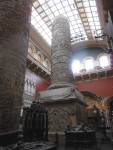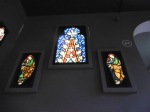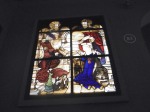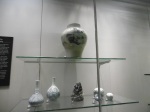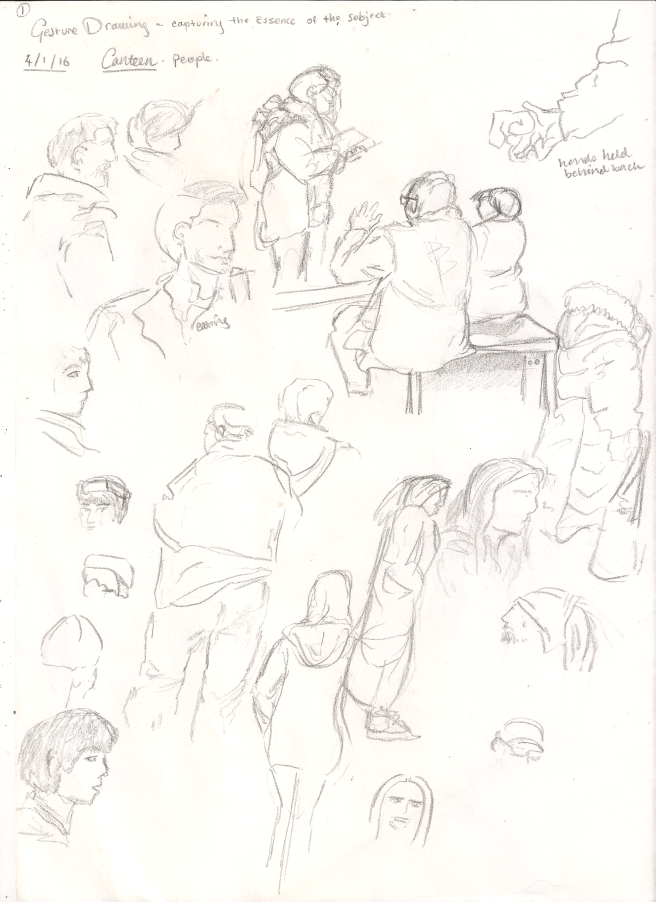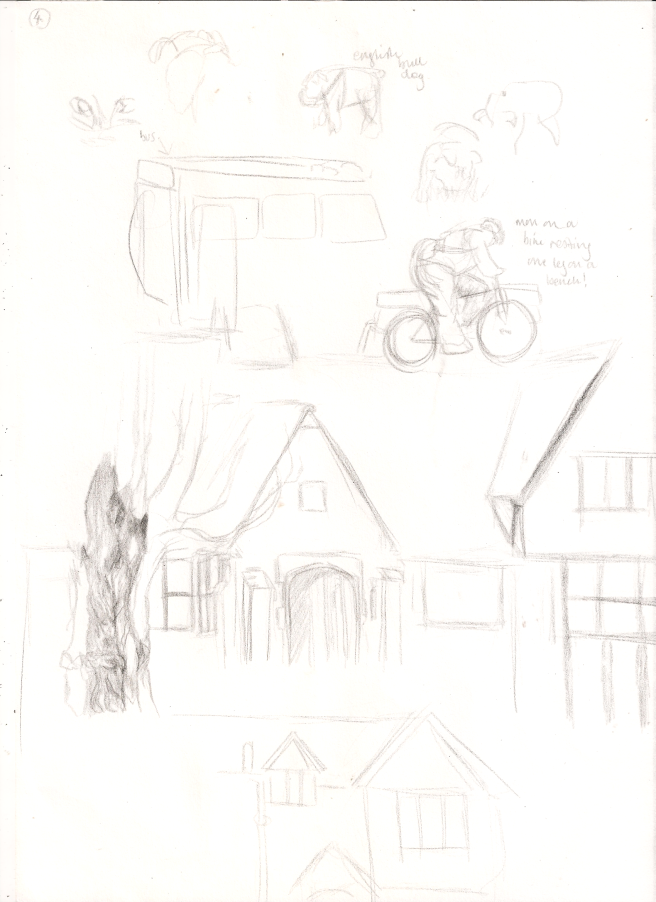Yesterday we headed off to the Victoria and Albert Museum to do our various drawings. I’d never been before and have never seen a wider collection of fascinating artifacts anywhere! There was just so much! It took 6 hours to get through just some of the criteria on our brief!
Our brief was to focus on cultures that weren’t our own, looking at how different cultures have developed their own “visual language”.
To begin with, this is a sketch I did of a Terracotta bust of Canon Edward Finch. (1728) by John Michael Rysbrack (1694 – 1770)
I just picked it out as it was characterful and realistic, two traits which I look for a lot in art – if I can positively connect with the piece then I find I empathise with it more. I liked Canon Finch’s knowing look and air of importance (not self-importance) he seemed wise and the sculpting nicely shows this off. I also love the detailing in the fold of his clothes.
I suppose you could say this can be my warm-up sketch, as this man is from my own culture. Still, I like this sort of work.
I then set off for Trajan’s column.
The architect of this column is thought to have been Apollodorus of Damascus and To describe it one word, I’d say “huge”.
This was my first impression of it. I felt completely dwarfed by the enormity of this incredible work. The level of detail is mind boggling. The whole column is entwined with various levels, each populated by thousands of figures, each filling out scenes in the story of the Roman Emperor Trajan’s victory over a people called the Dacians. There are 155 different scenes which spiral up the column like a comic strip. It may have been originally painted too, though nowadays of course it’s difficult to say what those colours may have been. The huge pedestal beneath it contained the Tomb of Trajan himself.
From there I moved on to Stained Glass.
This exhibition was lovely, truly beautiful. The installation itself was perfect – it was set along a long corridor with high windows on one side and a dark grey wall on the other with gleaming cabinets full of iridescent sacred silver. The darkness of the walls meant that all the colours in the illuminated stained glass were sang with gorgeous vibrancy.
Here, I was concentrating on how the figurative work is used to tell as story so I sketched the basic components of each scene to give myself an idea of how the lay-out and what devices were being employed to convey a narrative or message.
This is a sketch in the simplest possible form of the scene called The Annunciation (pictured above). It uses very clear imagery and symbolism (a recurring motif in stained glass) to convey the story of Gabriel announcing to the Virgin Mary that God has chosen her from all women to bare his son. Inbetween them is a dove representing the presence of the holy spirit. Both Gabriel and Mary have halos symbolising their holiness and Gabriel is gesturing upwards to heaven. There is also latin writing, which is like a speech bubble for Gabriel as he reassures Mary that she is blessed.
Here we have a scene (pictured above) from the Life of Saint John of Damascus. Similarly we can see the clear layout of the scene – Saint John is pictured on the right with a Halo denoting his status as a holy man. The man on the left is dressed in red (a powerful colour often denoting strength, passion or war-likeness) and is the Byzantine Emperor. He’s given status by being seated on a throne on a raised dais, i.e; he’s higher than everyone else. He’s gesturing towards Saint John, while Saint John is pointing to himself, indicating their discussing him. Saint John is pleading his innocence and there is a caption beneath written in Latin which translates as Saint John’s word, “God is my witness”. (The man inbetween is most likely a servant of the Byzantine Emperor and is holding a book open, perhaps indicating the law.)
I also sketched (but forgot to photograph, you can see the original via this link http://collections.vam.ac.uk/item/O8613/st-john-the-baptist-praying-panel-unknown/) the image of Saint John the Baptist praying in the wilderness. This caught my eye because of the number of animals depicted in the scene – we have some sort of pole-cat/stoat, a bear, a deer, a lion, a rabbit and a unicorn! It’s quite a mixture. It’s said that Saint John grew up in the wilderness. I just liked to see the dedication some artists put in to the life of the Saints.
From there, we move on to The Art of Indian Story-telling.
Story-telling is integral to Indian culture. Myths and Legends were told orally at first often through theatre and songs.
One of the methods of conveying a story was “Togalu Gombe Atta” – “Leather Puppet Dance”.
 This was the puppet on display – A warrior. The way Togalu Gombe Atta worked was lapns were lit being screens and shadows from the puppets were project on to these. Some plays could go on for days! There was also accompanying music and songs.
This was the puppet on display – A warrior. The way Togalu Gombe Atta worked was lapns were lit being screens and shadows from the puppets were project on to these. Some plays could go on for days! There was also accompanying music and songs.
This is a wonderful method of communicating a story and I found an example of this being employed in animation here,
Another way stories were told was with Playing Cards, “Ramayana Ganjifa”.
These circular sets, called “Ganjifa” are about the size of a drinks coaster. Each one depicts a scene from the story Ramayana, a popular tale about the hero Rama who has to rescue his wife Sita from the demon Ravana, with the help of the monkey god Hanuman.
There’s a huge amount of detail in these cards, they were really stunning and it’s a unique was of telling a story I had never considered before.
This gorgeous artefact is a Portable Shrine/Storyteller’s Box. These have been made in India for centuries. This example is called a “Kavadh” and the centre is a shrine to Sita (middle), the monkey god Hanuman (left) and Rama (right).
On the panels, scenes from the Ramayana and the life of Krishna are painted on. The panels were gradually opened and reveal a visual guide to the story as the storyteller opened them.
This is such a fantastic concept and this example is so beautifully painted, I love the use of reds and golds, it really brings out the characters painted.
I had a go at sketching them but I didn’t feel very confident about imitating the style and didn’t really want to. I didn’t feel right to copy this.
Moving on from India, I looked at visual communication in other regions of Southern and Eastern Asia, starting with Korea.
I found a collection of Porcelain pottery which caught my eye.
This pottery was from the Chosŏn Dynasty (also known as the Yi Dynasty).
Porcelain produced from pure white clay was reserved for the aristocracy. White had strong associations with Purity and Honesty and so was highly valued.
Cobalt blue was the favoured colour for decorating white porcelain and we can see some wonderful examples in the above images. I liked the subtly beauty of the floral sprays and could appreciate the work that had gone in to the more complex pieces.

One piece which caught my eye was called “Jar with Swelling Shoulders” (1750 – 1850) The main reason it caught my eye was the image in the middle set in an eight sided window and painted in the characteristic cobalt blue.
It depicts a boating party with birdlife, plant life and an imposing mountainous backdrop. I was drawn to the amount of detail and accuracy that went in to it. I enjoyed noticing little additions to the scene like the three people sitting in what seems to be a covered boat on the left.
I also liked the artists use of brush strokes to give depth to the scene; the water nearest to us has widely spaced ripples made with a single stroke. The water nearer the mountains has longer, denser strokes. This all added to the foundations of the scene, giving the whole image a sense of place. With a clear setting in a place that may well be real it suddenly gives the piece an extra dimension. It appears more genuine and makes the observer wonder what the history is behind it, to question and investigate it, drawing us in. That has surely got to be the mark of a good piece of visual communication.

I also briefly sketched a pair of flasks, as I found their shape pleasing as well as their patterns.

However one flask in particular had the most fantastic painting on it. A dramatic scene of a group of hunters. The central hunter was on horseback looking very fine with his bow helf aloft. I love horses and found the representation here enchanting. As well as this, as I drew I was amazed by the detail included – the Hunter’s fingernails, the little flushed blush marks on his cheeks and the brush strokes that make up the horses mane.
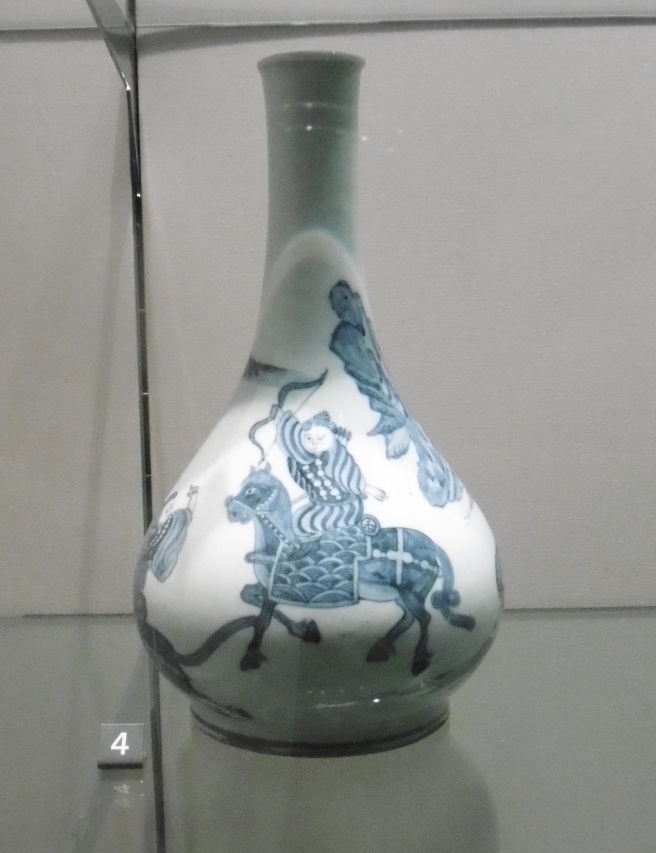
I tried to draw this in a similar shade of blue so I could better replicate it, of course that meant no erasing so it required an extra degree of concentration.

I feel ashamed I didn’t complete this one.
From Korean pottery to Buddhism! There was a whole array of Buddha’s all looking very impressive and peaceful down the same corridor as the Korean porcelain I had been admiring.
I was surprised to find out that there were so many meanings behind the statues and carvings – An information screen told me a huge amount about Figurative and Non-Figurative images of Buddha which proved fascinating.
Symbols in Buddhist sculpture have a wide variety of definitions. They may convey messages about the Buddha’s life and spiritual achievement or indicate the presence of Buddha. Or they might help us recognise us other important Buddhist figures such as Bodhisattvas like Avalokiteshvara and Tara.
Non-Figurative representations of Buddha.
Early on, Buddha wasn’t actually depicted in human form. Instead his presence was represented by symbols like Empty Thrones, Stupas or Dharmachakra.
An empty throne symbolises the seat of Buddha where he gained enlightenment. It also symbolises Buddha himself, as it suggests he’s the spiritual ruler of the world.

A Stupa is a monument which came to symbolise the Buddha’s passing in to “Mahaparinirvana” which is the highest state of Nirvana. It means the Buddha’s release form the cycle of rebirth. It’s said that the Buddha’s cremated remains were entombed in eight Stupas in eight separate locations, hence why the Stupa came to represent the Buddha’s transcendence to Mahaparinirvana.

There is also the Wheel of Law (or Dharmachakra)
The eight spokes of this wheel symbolise the Buddha’s spiritual path, which is known as the “Eightfold Path of the Noble Ones”. It also represents the first time Buddha gave his teachings, in Sarnath, north eastern India.
Footprints (or Buddhapada) are a symbol of the presence of Buddha. These draw on the Indian custom of revering a religious elder by touching your head to their feet. Buddhapada are often depicted with the Dharmachakra. The Tree of Enlightenment can be found in Buddhist sculpture and represents the tree under which the Buddha achieved enlightenment. As well as all these things, we can also find Triratanas (Three Jewels) which are the three corner stones of Buddhist religion.

Figurative representations of Buddha.
Various characters in Buddhism have various meanings depending on things such as Asanas (certain postures), Attributes (objects) and Mudras (hand gestures).
These are all very important because for Buddhists, these figures aren’t just representations; They embody the divine presence. Buddhists worship these and give offerings.
Mudras are brilliant! These are hand gestures that you can see in any image of Buddha or a Bhodisattva.
Each gesture has different meanings, primarily related to major events in the Buddha’s life or else symbolising states of mind or spiritual qualities.
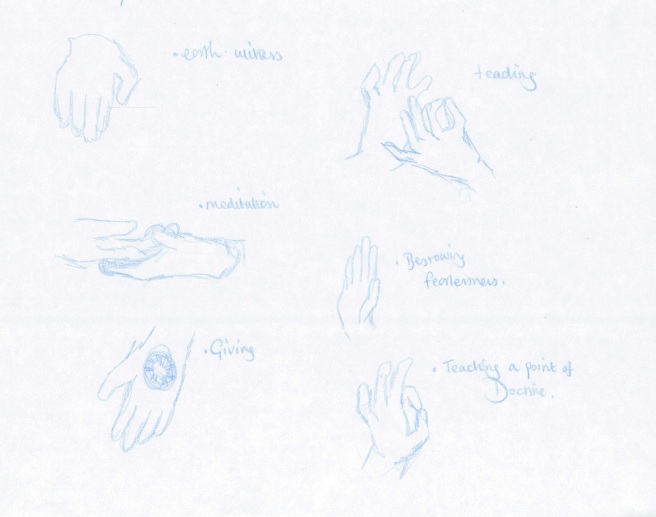
I then got very over-excited as I found examples of some of these in the surrounding exhibits!
Top right: Earth Witness, where the Buddha calls the Earth Goddess to witness his worthiness to become Buddha the moment before he achieves enlightenment.
Bottom right: Meditation
Left: a Bhodisattva (Tara) bestowing fearlessness.
It just goes to show how important an object can become. It’s amazing how people have created these symbols so as to understand, respect and communicate with their dieties.
After that, I feel no shame in confessing that after 6 hours in the museum I was thoroughly pooped and called it a day. But what a fascinating day it was! It’s certainly going to be a great resource for looking at different culture’s methods of visual communication!
We have an Assessment for Drawing, Drama and Design next monday which means no lessons that week or the week after. So keep an eye out for updates in a few weeks time!






